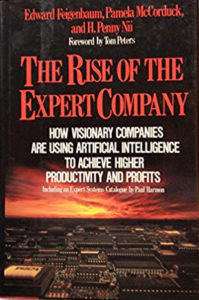Holy Grail of Supply Chain Management
Prof Ed Feigenbaum of Stanford University, one of the founders of AI, winner of the 1994 Turing Award (Noble Prize in Computer Science) identifies the next wave as “Community Intelligence” in his book The Rise of the Expert Company: How Visionary Companies are using AI”
“It is new kind of entity – a community intelligence born from the collective wisdom of various disciplines, experiences, and points of view, which dynamically disseminate the new intelligence around the same community that engendered it, solving problems that are too tough for us humans to figure out”(pp 63-64).
In this book, Prof Feigenbaum documents some current successful implementations.
The 2018 theme for the Gartner Supply Chain conference was Artificial Intelligence, the 2019 theme was digital supply chain, and clearly “community intelligence” is the theme for 2020. A detailed look at the successes described by Prof. Feigenbaum and related written material makes clear the importance of and challenge in capturing and using critical digital information of the demand-supply network; the importance of AI methods; and the emerging use of optimization methods. Community Intelligence synchronizes the use of these technologies in a manner that is focused on closing gaps in critical decision-making processes in the ongoing journey of more intelligent supply chains to improve organizational performance.

What is the catch? The book was published in 1988 (yes 1988)- about 2/3 of the way through the first “AI Wave”. Two years after the June 1986 Gartner conference on AI. To learn from the past, we need the experts to recognize the past, to help close gaps, a few of which are:
- Silos of Decisions remain intact – much of the success in supply chain management in the 1990s came from eliminating the data silos which provided a common agreed up set of data to support all decisions. However, the decisions made were at best loosely couple relying on asynchronous communication.
- In “demand-driven supply chains”, not over driving which can create its negative impact
- Data capture mechanisms that recognize the need to support decision making and not just accounting and production flow. For example, the initial production activity might involve brewing some basic ingredients to make the base material (might be cheese or a wafer) to support all downstream production). For accounting and production flow all that is needed is the start and packaged intermediate product put into inventory, where there is a lag between the two. The decision-making process needs “relevant-time” the quantity produced and the tool status.
- A single point estimate of demand that is provided by demand planning, purchase lead times from inventory planners, and business preferences from the executive that are in fact more fungible then some simple weights. In each case, the summary information is stored in one location, but the detail data and algorithms belong to each silo, even if they happen to be stored in the same server.
- Why is a result or a suggestion being made – explain
- More difficult then why, is what response/repair action to take? This is the bulk of what good planners do and this requires “deep knowledge” not in the sense of “deep machine learning” which simply means working through “two or layers of data and modification”, but an understanding of the demand-supply network
What is different in 2018 from 1988? The successes of 1988 were narrower in scope simply due to limitations in hardware and software and this type of work could only be done by large firms (DuPont, Chevron, IBM, etc.) As a result, the current loosely coupled silo approach became the standard to overcome hardware/software limitations and the growth of grind it out vendors of supply chain management software institutionalized this structure. Additionally, much of the current work in AI is done by “data scientists”, as opposed to decision scientists.
A quick read of this book and the initial central planning work in the 1990s should help any organization obtain a perspective helpful in their journey. One has to wonder at times, why the history is ignored.
Enjoyed this post? Subscribe or follow Arkieva on Linkedin, Twitter, and Facebook for blog updates.





